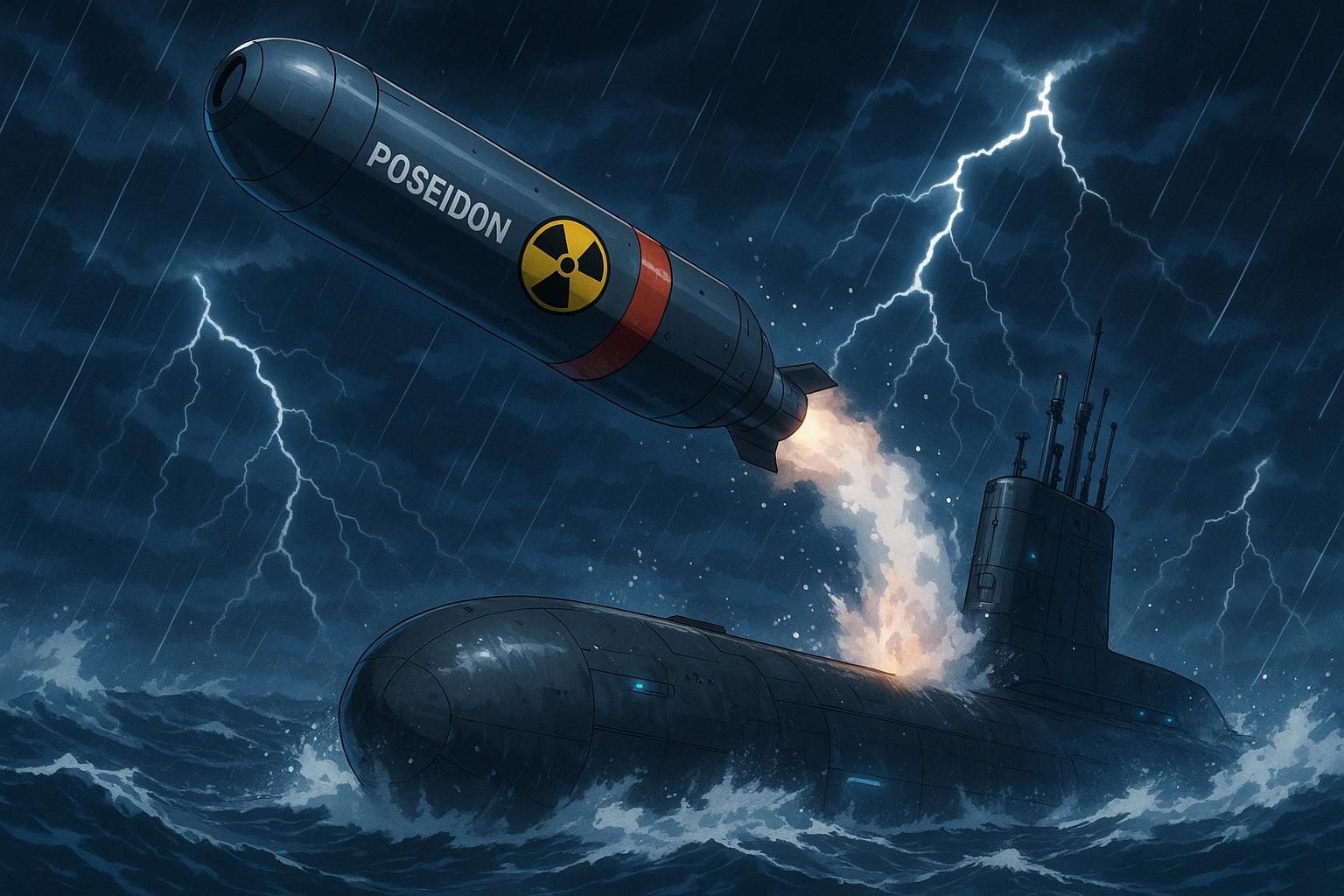Kremlin propagandist Vladimir Solovyov’s alarming threat of a “nuclear tsunami” against the US coincides with Russia completing production of Poseidon nuclear torpedoes, intensifying global concerns over Moscow’s escalating nuclear posturing and advanced military capabilities.
Recent statements from Vladimir Solovyov, a prominent Kremlin propagandist, have escalated the aggressive rhetoric surrounding Russia’s nuclear capabilities. In a televised rant, he threatened the United States with a “nuclear tsunami” that would “blow the country to hell,” a stark warning highlighting the Kremlin’s continued utilisation of nuclear sabre-rattling to deter Western support for Ukraine. As the US Senate considers new sanctions aimed at crippling Russia’s economy, these incendiary remarks come amid an increasing barrage of threats from Moscow, with a focus on its advanced military technologies.
This latest wave of nuclear rhetoric is not happening in a vacuum. The Russian government has been vocal about its development of new military technologies, particularly the Poseidon torpedo. Announced by President Vladimir Putin in 2018, the Poseidon is reported to be an intercontinental, nuclear-powered, nuclear-armed autonomous torpedo capable of travelling at high speeds. This weapon represents a significant leap in Russia’s military capabilities, designed specifically to penetrate US missile defence systems. According to strategic experts, the Poseidon torpedo could have catastrophic consequences for coastal cities, potentially resulting in widespread devastation and loss of life.
Reports indicate that the first production of Poseidon torpedoes, intended specifically for the Belgorod submarine, was completed earlier this year. This development underscores Russia’s ambition to solidify its deterrence strategy through innovative weaponry. The production of nuclear warheads for these torpedoes further demonstrates Moscow’s commitment to enhancing its nuclear arsenal, aimed at reinforcing its military posture both regionally and globally.
Current military analyses suggest that Russia may be looking to produce as many as 30 Poseidon torpedoes. This planned expansion not only signals a shift in the dynamics of nuclear deterrence but also emphasises the strategic implications for Western nations, especially considering the torpedoes’ ability to target aircraft carrier groups and other high-value coastal assets. Such capabilities exacerbate fears of an arms race and increase the urgency for NATO and other Western powers to reassess their security strategies in response to Russia’s evolving military threats.
In light of these developments, the rhetoric from Solovyov is deeply emblematic of a broader narrative that the Russian state is constructing—a narrative asserting that any attempt to undermine or threaten Russia will be met with overwhelming nuclear force. This perspective is not only a means of solidifying domestic support but is also intended to send a clear message to adversaries in a rapidly changing geopolitical landscape. Russia’s focus on advanced military technology, combined with this vigorous verbal posturing, signals a volatile mix in the current international relations arena, particularly for nations considering their own defence strategies in the face of such threats.
The potential ramifications of these developments are profound, highlighting the pressing need for diplomatic engagement and strategic dialogue to mitigate the risks associated with nuclear proliferation and the threats posed by advanced military capabilities. As the world watches these developments unfold, the imperative for international stability remains paramount.
Reference Map
- Paragraph 1, 2, 3, 4, 5, 6
- Paragraph 2, 4, 6
- Paragraph 3, 4
- Paragraph 2, 4, 6
- Paragraph 2, 4
- Paragraph 2, 4, 6
Source: Noah Wire Services
- https://www.express.co.uk/news/world/2057466/putin-russia-nuclear-weapons-poseidon-usa – Please view link – unable to able to access data
- https://www.themoscowtimes.com/2023/01/16/military-source-claims-russia-has-completed-first-poseidon-super-torpedoes-a79959 – In January 2023, Russian state-run news agency TASS reported that Russia had produced the first set of Poseidon nuclear-capable super torpedoes. These torpedoes are designed for deployment on the Belgorod special-purpose nuclear submarine. The Poseidon is an intercontinental, nuclear-powered, nuclear-armed autonomous torpedo, first announced by President Vladimir Putin in 2018. The production of these torpedoes marks a significant advancement in Russia’s strategic military capabilities, with the Belgorod submarine expected to receive them in the near future.
- https://thebulletin.org/2023/06/one-nuclear-armed-poseidon-torpedo-could-decimate-a-coastal-city-russia-wants-30-of-them/ – The Bulletin of the Atomic Scientists discusses the Poseidon torpedo as an evolution in Russia’s nuclear deterrence strategy. The Poseidon is an intercontinental, nuclear-powered, nuclear-armed autonomous torpedo, capable of delivering both conventional and nuclear warheads. It is speculated that Russia aims to produce at least 30 of these torpedoes, reflecting a significant shift in nuclear strategy. The Poseidon is designed to circumvent U.S. ballistic missile defenses and could be used against aircraft carrier groups and coastal targets, potentially threatening strategic stability.
- https://www.deccanherald.com/world/russia-produces-first-nuclear-warheads-for-poseidon-super-torpedo-1181529.html – In January 2023, Russia’s defense ministry announced the production of the first nuclear warheads for the Poseidon super torpedo. The Poseidon is a nuclear-powered, nuclear-armed autonomous torpedo designed for intercontinental range and high-speed travel. President Vladimir Putin first announced the Poseidon in 2018, describing it as a fundamentally new type of nuclear weapon. The torpedo is intended to be launched from nuclear submarines, with the Belgorod submarine being one of the platforms for its deployment.
- https://www.jpost.com/international/article-735534 – Russia plans to complete the construction of coastal infrastructure in the Pacific Ocean by early 2024 to base nuclear submarines carrying the Poseidon nuclear-capable super torpedoes. The Poseidon is an intercontinental, nuclear-powered, nuclear-armed autonomous torpedo, first announced by President Vladimir Putin in 2018. The torpedoes are being developed for deployment on the Belgorod and Khabarovsk nuclear submarines. This development indicates Russia’s ongoing efforts to enhance its strategic military capabilities in the Pacific region.
- https://www.businessinsider.com/state-media-russia-built-first-batch-poseidon-torpedoes-super-weapon-2023-1 – Russian state media reported the production of the first batch of Poseidon nuclear-powered torpedoes, a ‘super weapon’ designed for intercontinental range and high-speed travel. The Poseidon is an intercontinental, nuclear-powered, nuclear-armed autonomous torpedo, first announced by President Vladimir Putin in 2018. The torpedo is intended to be launched from nuclear submarines, with the Belgorod submarine being one of the platforms for its deployment. The development of the Poseidon reflects Russia’s ongoing efforts to enhance its strategic military capabilities.
- https://www.jpost.com/breaking-news/article-728658 – In January 2023, Russia’s defense ministry announced the production of the first nuclear warheads for the Poseidon super torpedo. The Poseidon is a nuclear-powered, nuclear-armed autonomous torpedo designed for intercontinental range and high-speed travel. President Vladimir Putin first announced the Poseidon in 2018, describing it as a fundamentally new type of nuclear weapon. The torpedo is intended to be launched from nuclear submarines, with the Belgorod submarine being one of the platforms for its deployment.
Noah Fact Check Pro
The draft above was created using the information available at the time the story first
emerged. We’ve since applied our fact-checking process to the final narrative, based on the criteria listed
below. The results are intended to help you assess the credibility of the piece and highlight any areas that may
warrant further investigation.
Freshness check
Score:
8
Notes:
The narrative discusses recent events and developments in Russia’s nuclear capabilities, such as the Poseidon torpedo, which suggests a contemporary context. However, the topic itself is not new and has been discussed in previous years.
Quotes check
Score:
6
Notes:
The narrative includes quotes from Vladimir Solovyov, but specific dates or original sources for these quotes are not provided. This could be a standard trope of aggressive rhetoric from Russian officials.
Source reliability
Score:
7
Notes:
The narrative originates from the Express, a British tabloid newspaper known for sensationalism. While the Express is a reputable source in the UK, its sensationalism can affect the reliability of the content.
Plausability check
Score:
9
Notes:
The claims about Russia’s nuclear capabilities and the Poseidon torpedo are plausible given recent geopolitical tensions and military developments. However, the specific details about production numbers and strategies may require further verification.
Overall assessment
Verdict (FAIL, OPEN, PASS): OPEN
Confidence (LOW, MEDIUM, HIGH): MEDIUM
Summary:
The narrative is contemporary and discusses plausible developments in Russia’s nuclear capabilities. However, the reliability of the source and the unverified nature of some quotes and details warrant caution. Further verification is needed to confirm the accuracy of specific claims.













